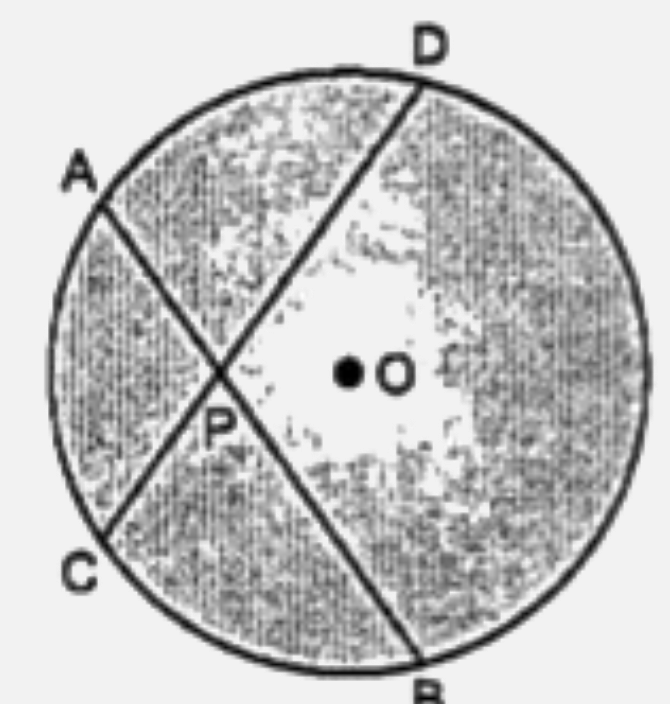Let the vertex of an angle ABC be located outside a circle and let the sides of the angle intersect equal chords AD and CE with the circle. Prove that ∠ABC is equal to half the difference of the angles subtended by the chords AC and DE at the centre.
To prove that angle ∠ABC is equal to half the difference of the angles subtended by the chords AC and DE at the center of the circle, we can follow these steps:
Step 1: Define the Angles
Let:
- ∠AOC be the angle subtended by chord AC at the center of the circle.
- ∠DOE be the angle subtended by chord DE at the center of the circle.
Step 2: Use the Exterior Angle Theorem
In triangle BDC:
- The angle ∠ADC is an exterior angle. According to the exterior angle theorem, we have:
∠ADC=∠DBC+∠DCB
Step 3: Relate Angles at the Circle to Angles at the Center
According to the inscribed angle theorem:
- The angle subtended at the center is twice the angle subtended at the circumference. Therefore:
∠ADC=12∠AOC
∠DCB=12∠DOE
Step 4: Substitute the Angles into the Exterior Angle Equation
Substituting the expressions for ∠ADC and ∠DCB into the equation from Step 2 gives us:
12∠AOC=∠DBC+12∠DOE
Step 5: Rearrange the Equation
Rearranging the equation to isolate ∠DBC:
∠DBC=12∠AOC−12∠DOE
Step 6: Factor Out the Common Term
Factoring out 12 from the right side:
∠DBC=12(∠AOC−∠DOE)
Step 7: Conclude the Proof
Since ∠DBC is the same as ∠ABC (as they are corresponding angles), we conclude:
∠ABC=12(∠AOC−∠DOE)
This proves that ∠ABC is equal to half the difference of the angles subtended by the chords AC and DE at the center.
Let:
- ∠AOC be the angle subtended by chord AC at the center of the circle.
- ∠DOE be the angle subtended by chord DE at the center of the circle.
In triangle BDC:
- The angle ∠ADC is an exterior angle. According to the exterior angle theorem, we have:
∠ADC=∠DBC+∠DCB
According to the inscribed angle theorem:
- The angle subtended at the center is twice the angle subtended at the circumference. Therefore:
∠ADC=12∠AOC
∠DCB=12∠DOE
Substituting the expressions for ∠ADC and ∠DCB into the equation from Step 2 gives us:
12∠AOC=∠DBC+12∠DOE
Rearranging the equation to isolate ∠DBC:
∠DBC=12∠AOC−12∠DOE
Factoring out 12 from the right side:
∠DBC=12(∠AOC−∠DOE)
Since ∠DBC is the same as ∠ABC (as they are corresponding angles), we conclude:
∠ABC=12(∠AOC−∠DOE)
This proves that ∠ABC is equal to half the difference of the angles subtended by the chords AC and DE at the center.
Topper's Solved these Questions
Similar Questions
The chord of a circle is equal to its radius, find the angle subtended by this chord at the centre.
View SolutionIf the chord of a circle is equal to the radius of the circle, then the angle subtended by the chord at a point on the minor arc is .........
View SolutionTwo chords AB and CD intersect at P inside the circle . Prove that the sum of the angles substended by the arcs AC and BD at the centre O is equal to twice the angle APC.
View SolutionTwo equal chord AB and CD of a circle with centre O, intersect each other at point P inside the circle.

Prove that:
BP=DP
View SolutionProve that a diameter of a circle which bisects a chord of the circle also bisects the angle subtended by the chord at the centre of the circle.
View SolutionTwo chords AB and AC of a circle are equal. Prove that the centre of the circle lies on the angle bisector of ∠BAC.
View SolutionTwo chords AB and AC of a circle are equal. Prove that the centre of the circle lies on the angle bisector of ∠BAC.
View SolutionA chord of a circle is equal to the radius of the circle. Find the angle subtended by the chord at a point on the minor arc and also at a point on the major arc.
View SolutionA chord of a circle is equal to the radius of the circle find the angle subtended by the chord at a point on the minor arc and also at a point on the major arc.
View SolutionA chord of a circle is equal to the radius of the circle find the angle subtended by the chord at a point on the monor arc and also at a point on the major arc.
View Solution
